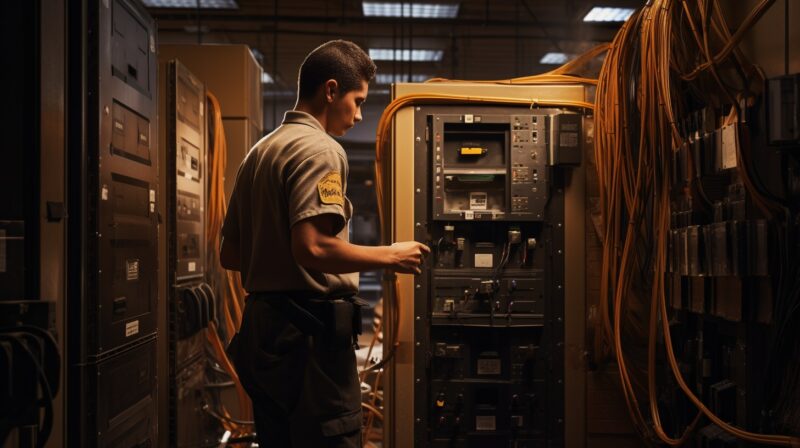One of the most critical elements of a data center’s infrastructure, an uninterruptible power supply (UPS) is a device that provides emergency power to a facility in the event that the primary power source fails. The UPS system often only provides power for a short period of time, but it keeps key systems operating until power is restored or backup generators come online to provide power.
Maintaining these systems is critical to effective data center operations. Without a UPS of some kind in place, facilities will be vulnerable to costly downtime incidents that can negatively impact business operations. Given the important role of fault tolerance and data center redundancy, it’s vital that effective procedures are in place to maintain UPS systems for the moment they’re needed most.
5 Key Strategies for UPS System Maintenance

Make a Schedule (and Keep To It)
This might seem obvious, but given all the demands of day-to-day data center operations, it’s easy to take things like backup systems for granted. Taking a proactive approach to servicing and maintaining an uninterruptible power supply is the first step toward protecting a data center from a system downtime event by keeping its servers up and running.
Backup systems should be inspected on a regular basis to ensure that every aspect of the UPS, including the static bypass circuit, the rectifier, the inverter, and the battery itself, is functioning properly. Data center managers need to provide a detailed checklist for these inspections so that each unit receives the attention it deserves.
Create Documentation
The typical lifespan of a UPS system is about 13 years, but the individual components of a unit are likely to wear out long before that. While these components can be replaced, their shorter lifecycle means that an uninterruptible power supply must be monitored closely to avoid potential failures. Performing regular inspections according to clearly defined protocols creates a good foundation for documentation.
These records can help data center personnel to evaluate the life expectancy of different UPS components and identify when failures or other problems have occurred. This removes much of the guesswork out of maintenance and provides a far more accurate picture of UPS performance than a simple pass/fail inspection.

Inspect Batteries Closely
When a UPS system fails, it’s usually because something went wrong with the battery. Although batteries have an expected lifespan of four to five years, circumstances can have a major impact on how long it lasts. They are extremely temperature sensitive, so storing a UPS in a room that’s too hot or too cold could have an impact on battery life.
Repeated cycling usage and improper float voltage may also cause a battery to wear out faster than the manufacturer suggests. Due to all of these factors, it’s important to inspect batteries carefully during maintenance to ensure data center redundancy. Visual inspections, voltage testing, and thermal scans should all be utilized to make an accurate assessment of battery health.
Check the UPS Environment
While UPS system maintenance itself is important, other environmental factors may cause it to perform below expectations in the event of a power disruption. Deteriorating or poorly installed wiring might interrupt efficient power transfer, dirt or dust could restrict air flow, and moisture could corrode connections.
Even if the UPS’s surroundings don’t seem to be affecting its performance, they could cause components to fail more quickly, resulting in increased downtime risks and higher maintenance costs over time. Ensuring that a UPS is stored in a clean, controlled environment is a simple but effective step in the maintenance process.

Perform Regular Load Bank Testing
Physical inspections are important, but no UPS maintenance process is really complete without load bank testing to find out how well the system performs when it’s needed most. A load bank test simulates a power disruption by connecting the uninterruptible power supply to an electrical load that matches the load it would need to support in a real outage.
The test will quickly reveal any problems or failures, including the UPS components itself and associated battery strings. While a load bank test is the most thorough form of maintenance, it can be time intensive and expensive to perform. For this reason, they should be considered a supplement to ongoing inspections and preventative maintenance rather than a replacement.
When it comes to preventing the costly effects of system downtime, data centers rely heavily upon the performance of their UPS systems. By carrying out regular maintenance on these systems and their components, data centers can ensure that their redundancy plans will operate as expected when they need them most.
FAQs
What is the primary function of a UPS in a data center?
The primary function of a UPS (Uninterruptible Power Supply) in a data center is to provide emergency power to the facility in the event of a primary power source failure, ensuring continuous operation until power is restored or backup generators are activated.
How often should a UPS system be inspected?
While the frequency can vary based on the specific UPS system and its usage, it’s recommended to inspect backup systems regularly, with some experts suggesting quarterly or bi-annual inspections.
What are the common causes of UPS battery failure?
Common causes include temperature fluctuations, repeated cycling usage, improper float voltage, and age. Batteries are typically expected to last four to five years, but various factors can shorten this lifespan.
Can a UPS system operate without a battery?
No, the battery is a critical component of a UPS system. Without it, the UPS cannot provide emergency power during an outage.
How can I extend the lifespan of my UPS battery?
Ensuring the UPS is stored in a temperature-controlled environment, avoiding repeated cycling usage, and ensuring proper float voltage can help extend the battery’s lifespan.
Is it necessary to replace the entire UPS system when a component fails?
Not always. Many times, individual components of a UPS system, like batteries or circuits, can be replaced without needing to replace the entire system.
What is the significance of load bank testing for a UPS?
Load bank testing simulates a real power disruption, allowing data center managers to assess how well the UPS system performs under actual outage conditions.
Final Words:
Maintaining the UPS system is not just about ensuring power continuity; it’s about safeguarding the very backbone of modern businesses – the data center. With the right maintenance practices, data centers can operate efficiently, ensuring that businesses remain resilient in the face of unexpected power disruptions.
Related Posts:
- Seasonal Pond Care - Essential Tips for Year-Round…
- Essential Pond Maintenance Tips for a Healthy Ecosystem
- The Benefits of Implementing a Knowledge Management…
- Why Invest in a Warehouse Intercom System?
- Can You Beat the System? Debunking Myths About Slot Machines
- 5 Valid Reasons to Put Money into a Home Security System








